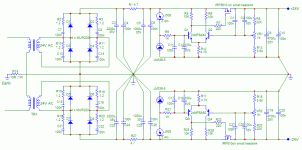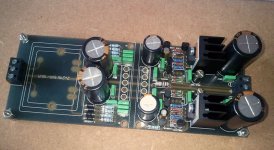Thank you kind Sir .
Will I need to use 1 amp slow for 230 VAC here ? What are the 1 amp diodes ?
Could you send it to my email please . I can just save it to desk top that way .
Cheers , Rich
I usually just follow the fuse recommendations of the transformer manufacturer. Amplimo (the transformers I use) specifies the fuse on the data sheet.
About the fuse:
Power = V * A. You use a fuse to ensure that the system will draw no more power than it can safely handle.
A 50VA transformer will be able to handle 50VA / 115V = 0.43A or about 0.5A. At 230V it would be able to handle (50 / 230 = 0.22 or) about 0.25A .
Although I would recommend following the advice of the transformer manufacturer, if a fuse is rated at X Amps for 115V you must divde by 2 for 230V.
In the original Pearl II PSU (as in the Pearl II paper by Wayne) a 0.5A fuse is mentioned for 115V, so 0.25A would be required for 230V.
Power = V * A. You use a fuse to ensure that the system will draw no more power than it can safely handle.
A 50VA transformer will be able to handle 50VA / 115V = 0.43A or about 0.5A. At 230V it would be able to handle (50 / 230 = 0.22 or) about 0.25A .
Although I would recommend following the advice of the transformer manufacturer, if a fuse is rated at X Amps for 115V you must divde by 2 for 230V.
In the original Pearl II PSU (as in the Pearl II paper by Wayne) a 0.5A fuse is mentioned for 115V, so 0.25A would be required for 230V.
What advantage would MUR820's bring compared to an ordinary rectifier bridge? I currently have Diotec B40C5000 bridges (planning to build the original power supply for the Pearl 2 with a 2x24V transformer). Will I benefit in some way by buying 8MUR820's and make bridges out of them?
The MUR820 diode is very, very fast recovery. This makes a difference in PSU noise and smoothness.
At burning amp, I had a chance to talk to Wayne, and he said that fast-recovery diodes made a difference in line-level components, and were worth using.
However, you should use the parts you have on hand to get the project running and tested, and once you are happy with the performance, change parts to 'fine-tune'.
At burning amp, I had a chance to talk to Wayne, and he said that fast-recovery diodes made a difference in line-level components, and were worth using.
However, you should use the parts you have on hand to get the project running and tested, and once you are happy with the performance, change parts to 'fine-tune'.
Euro Members,
I'm looking for a supplier of good quality transformers for my projects ..
Can anyone help ?
Thanks , Rich
I'm looking for a supplier of good quality transformers for my projects ..
Can anyone help ?
Thanks , Rich
what you want is "soft recovery" more so than high speed for your rectifiers.
there was some good discussion in past years. i don't have links handy but a search should bring them up.
good luck,
mlloyd1
there was some good discussion in past years. i don't have links handy but a search should bring them up.
good luck,
mlloyd1
What advantage would MUR820's bring compared to an ordinary rectifier bridge? I currently have Diotec B40C5000 bridges (planning to build the original power supply for the Pearl 2 with a 2x24V transformer). Will I benefit in some way by buying 8MUR820's and make bridges out of them?
Euro Members,
I'm looking for a supplier of good quality transformers for my projects ..
Can anyone help ?
Thanks , Rich
I use Amplimo transformers (I understand that on this board they are the recommended EU brand). They are not cheap but I have recently seen that they have new, lower-priced, made-in-China transformers (besides the original made-in-UK products). No idea how good the made-in-China are.
Amplimo have a webshop and ship worldwide. Try www.amplimo.nl or the webshop at www.ringkerntrafo.nl .
I have one from Block; RTE50 2x24V. Conrad sells them. I have no idea if these have a good reputation, but they seem well built and are not really cheap. As far as I understand from their website, their products are made in Germany, not sourced from China.
See Block-trafo.de
See Block-trafo.de
Thank you both...... now I'm spoilt for choice . The price seems reasonable and about what I'd planned to spend .
I need to order for the B1 also .... So, if my personal gurus are watching could they please check the sites out and spec for me ...... ?
Rich
I need to order for the B1 also .... So, if my personal gurus are watching could they please check the sites out and spec for me ...... ?
Rich
cheers Marra .
is that what Nar used ? ..... perhaps he could chime in if around . I know nothing about R cores ..... Please try and remember I'm on a very steep learning curve 😀.
I will gladly consider it . However, this close to Christmas $$$$$ is an issue . I need to talk it over with 6L6 . He has been kind enough to take me under his wing for this project . I will do as I'm told . I need to keep it simple ... KISS
Rich
is that what Nar used ? ..... perhaps he could chime in if around . I know nothing about R cores ..... Please try and remember I'm on a very steep learning curve 😀.
I will gladly consider it . However, this close to Christmas $$$$$ is an issue . I need to talk it over with 6L6 . He has been kind enough to take me under his wing for this project . I will do as I'm told . I need to keep it simple ... KISS
Rich
I believe its something to do with the fact that the primary and secondary windings are separate and therefore there is less interaction plus the regulation is a lot better. I used one in my DCB1 build and it is dead quiet.
That makes sense ...
Can you PM me me more details . I had a look at the website ,but did not fair too well finding what I was looking for .
Rich
Can you PM me me more details . I had a look at the website ,but did not fair too well finding what I was looking for .
Rich
R-core and Toroidal are both appropriate for the Pearl 2 PSU. Heck, as the PSU needs to be in a separate case, for noise performance, (I.E., far away from the circuit) you could get away with a EI core.
Anyway, any of those suppliers all look good. Get a 50VA 22v+22v (ideal) or 24v+24v (still very good) Dual primary or single 230v, it doesn't matter.
Anyway, any of those suppliers all look good. Get a 50VA 22v+22v (ideal) or 24v+24v (still very good) Dual primary or single 230v, it doesn't matter.
cheers Marra .
is that what Nar used ? ..... perhaps he could chime in if around . I know nothing about R cores ..... Please try and remember I'm on a very steep learning curve 😀.
I will gladly consider it . However, this close to Christmas $$$$$ is an issue . I need to talk it over with 6L6 . He has been kind enough to take me under his wing for this project . I will do as I'm told . I need to keep it simple ... KISS
Rich
nAr used a 2 x 24V 300VA RCore from Selectronic 😉 And Mundorf MLytic Capacitors 😎
But I'm currently planning to use the same PSU as I have in the UGS preamp.
Reason is, it will sound probably better than the actual onboard 7824/7924.
It is a design by CheefDeGaar, and it is inspired from the Pearl 1 regulation. As you can see, Flat made the PSU bipolar, symmetrical.
It is 24V OUT and has very good regulation, silent, and is ajustable to your needs.
The diodes are MUR160, ultra fast diodes along with RC snubbers.
There's also a Pi filter before the regulation. Layout is compact so it's practical.
I'm also preparing a 30V flavour to upgrade my current AlephOno PSU. And Yes, I love RIAA stages 😉
Best,
nAr
Attachments
Layout done (I think ...)
Hi guys,
I think I have determined the layout for my Pearl 2. It will consist of 3 boxes: 1 for each channel and 1 for the PSU. The boxes are 230 wide x 280 deep x 80 high full aluminium Galaxy Maggiorato from Modushop/Hifi 2000. modu
Power from the PSU box to each amp box is via a 3 wire shielded cable using XLR4 connectors. I am using the standard PSU. As it is in a separate box it is easy to change/upgrade later.
Enclosed a pdf of the layout. Comments please!
Thanks,
Albert
Hi guys,
I think I have determined the layout for my Pearl 2. It will consist of 3 boxes: 1 for each channel and 1 for the PSU. The boxes are 230 wide x 280 deep x 80 high full aluminium Galaxy Maggiorato from Modushop/Hifi 2000. modu
Power from the PSU box to each amp box is via a 3 wire shielded cable using XLR4 connectors. I am using the standard PSU. As it is in a separate box it is easy to change/upgrade later.
Enclosed a pdf of the layout. Comments please!
Thanks,
Albert
Attachments
Inspiring as all ways Nar .... I have 2 M-lytics I could use 10000 uf 40V . The others are Nichicon 10000 50 v . I have used 4 in total . If I was to change them on the PSU which 2?
Albert - Wow! That is a very nice plan. I like overkill. 😀 😀 😀 It's what makes DIY fun.
Thanks 6L6. The 3 box design (i.e. separating the channels) was born when I found out that 2 small boxes were the same price as 1 large box. Simple choice!
As to the detailing: In my case I specify so much detail because I do not do the actual building. I haven't got the strength to do any of the actual work (I use an electric wheelchair), but a friend of mine does it for me. This way I am sure we are on the same page.
He does the actual build but I do parts selection and buy all the parts and then have to think about layout and all the other things that come up. An advantage is that by going into all the detail beforehand (i.e. simulating the build on paper) I run into the same problems other people do when they are actually building it, but at a time when it is very easy to make changes.
Albert
- Home
- Amplifiers
- Pass Labs
- Pearl Two

